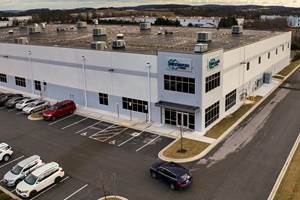Imagining the utility of IoT in our increasingly data-driven age
CompositesWorld's editor-in-chief Jeff Sloan imagines one potential outcome of the Internet of Things: inline composite part inspection.
It’s been more than a decade since I first heard about the possi- bility of my refrigerator, dishwasher, thermostat, toaster or teapot being plugged into the Internet. I was at a housewares tradeshow in Chicago, for my previous job, and Internet-capable appliances were touted there as the next line of products destined to make human life better and easier. I can’t remember how they were going to make my life better, but there seemed to be no end of enthusiasm for the concept.
If you missed that wave of Internet-based excitement, don’t worry, because it’s back, with new terminology, new application, and — thankfully — actual utility. The terminology you’ve probably heard already: Industry 4.0, Internet of Things (IoT), Fourth Industrial Revolution, Cyber-Physical Systems (CPS). For simplicity, I’ll stick with IoT.
The principle of IoT can be boiled down to one basic idea: The exchange of data among devices to enhance device performance and expedite decision-making. In this way, IoT has utility in myriad places, including consumer products (refrigerator!), energy networks, transportation networks, buildings and homes, healthcare and, of course, manufacturing. And, more specifically, composites manufacturing.
IoT in composites manufacturing is especially appealing; our industry’s long history of dependence on manual labor (hand layup, sprayup), followed by a rapid migration to automation today, begs for the kind of data that IoT offers. Such data allow people and manufacturing systems to track, manage and act on the material and machinery variables for which the composites industry is famous/infamous, thereby giving fabricators just a little more control over their manufacturing processes.
There is, however, one aspect of IoT in composites fabrication that is only just now starting to come to life, and I believe it has the potential to have a profound effect on the quality and efficiency with which we make our products. I will call this IoT tool in-situ quality control, or, IQS if you prefer.
One thing we often overlook when we think and talk about composites is that it is one of the very few materials that is actually made during part production. That is, a composite comprises two or more constituent materials that are not combined until part fabrication is begun. This means that from the moment liquefied resin comes in contact with fiber, we have not only started making a composite part or structure, but we have also started making the final composite material. Which, in many ways — particularly if you’re used to working with steel, aluminum or other amorphous materials — is crazy. It means that from the get-go we intentionally introduce variables (two dissimilar materials) that are destined to affect (potentially negatively) final part quality.
Overcoming these variables used to require a mix of knowledge, experience, faith and luck that is unnecessary in many other manu- facturing processes. And when everything was going your way, those variables came together to make a beautiful composite structure, but when knowledge, experience, faith or luck fell short, you were left with a very expensive mistake.
IQS, which is being developed by several suppliers, is an emerging technology realm that offers composites fabricators a chance to, basically, check their work as they go. IQS, in the form of video, nondestructive evaluation and other technologies, will check for gaps, wrinkles, bridging, voids, foreign object debris, delamination, waviness, resin richness, dimensional accuracy and more. IQS will help you identify problems when they are easier and less expensive to fix. IQS will jump in when knowledge, experience, faith or luck struggle.
Your refrigerator may or may not be surfing the Internet soon, but on the shop floor, IoT has real utility and application to help make composites manufacturing quality more reliable and consistent.
Related Content
Hexagon Purus opens new U.S. facility to manufacture composite hydrogen tanks
CW attends the opening of Westminster, Maryland, site and shares the company’s history, vision and leading role in H2 storage systems.
Read MoreHonda begins production of 2025 CR-V e:FCEV with Type 4 hydrogen tanks in U.S.
Model includes new technologies produced at Performance Manufacturing Center (PMC) in Marysville, Ohio, which is part of Honda hydrogen business strategy that includes Class 8 trucks.
Read MoreMingYang reveals 18-MW offshore wind turbine model with 140-meter-long blades
The Chinese wind turbine manufacturer surpasses its 16-MW platform, optimizes wind farm construction costs for 1-GW wind farms.
Read MoreInfinite Composites: Type V tanks for space, hydrogen, automotive and more
After a decade of proving its linerless, weight-saving composite tanks with NASA and more than 30 aerospace companies, this CryoSphere pioneer is scaling for growth in commercial space and sustainable transportation on Earth.
Read MoreRead Next
VIDEO: High-volume processing for fiberglass components
Cannon Ergos, a company specializing in high-ton presses and equipment for composites fabrication and plastics processing, displayed automotive and industrial components at CAMX 2024.
Read More“Structured air” TPS safeguards composite structures
Powered by an 85% air/15% pure polyimide aerogel, Blueshift’s novel material system protects structures during transient thermal events from -200°C to beyond 2400°C for rockets, battery boxes and more.
Read MoreDeveloping bonded composite repair for ships, offshore units
Bureau Veritas and industry partners issue guidelines and pave the way for certification via StrengthBond Offshore project.
Read More


















